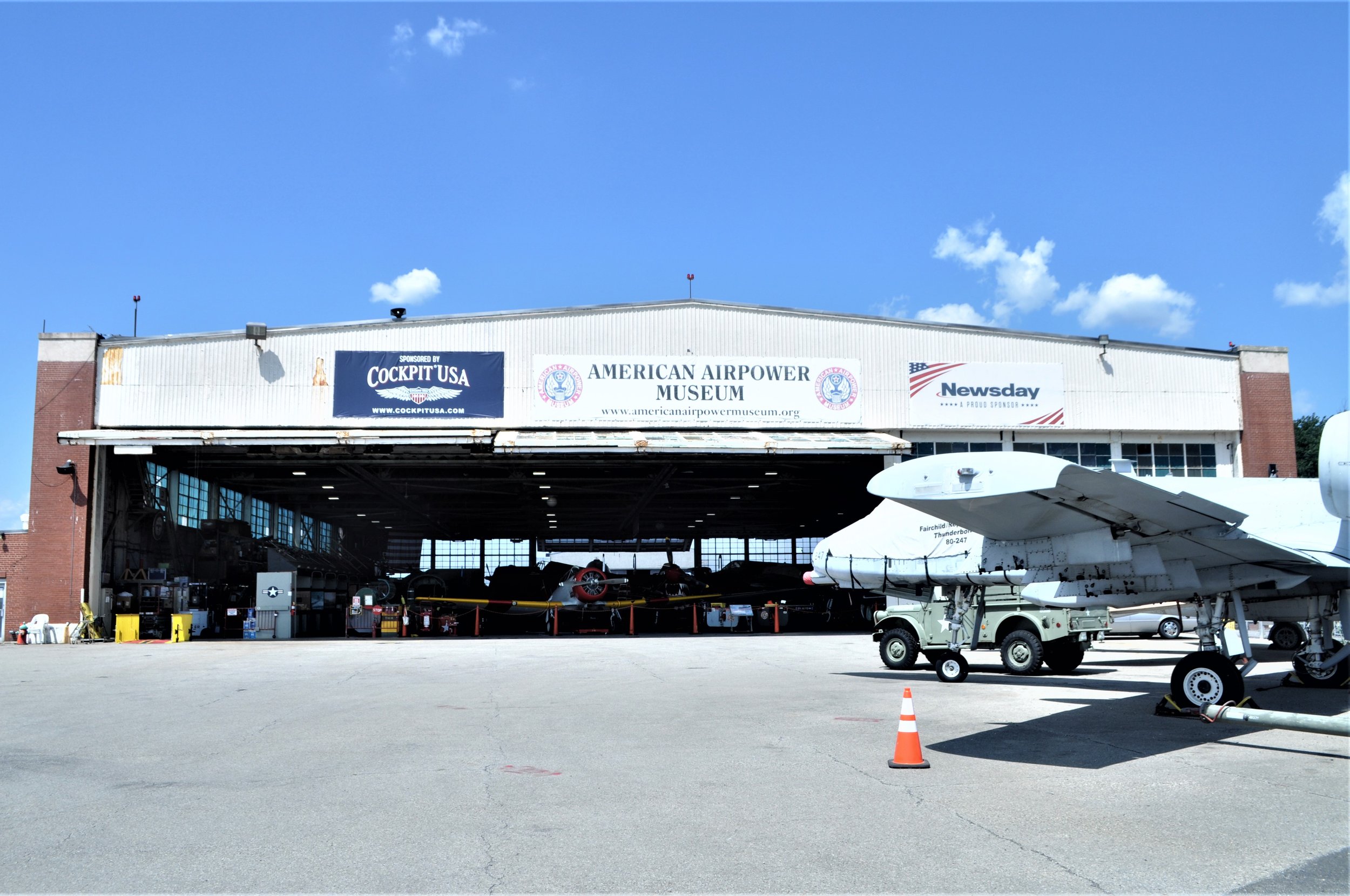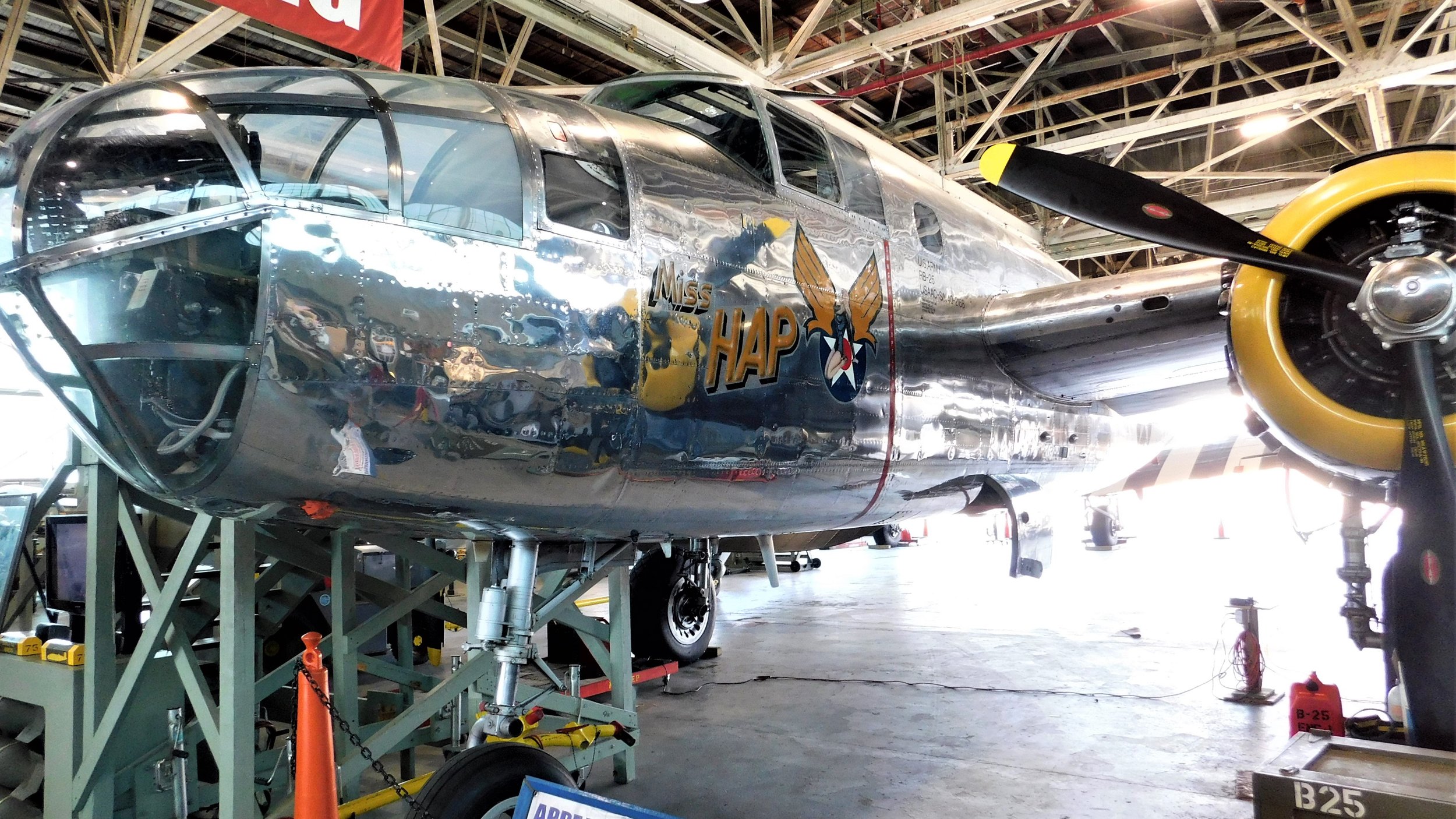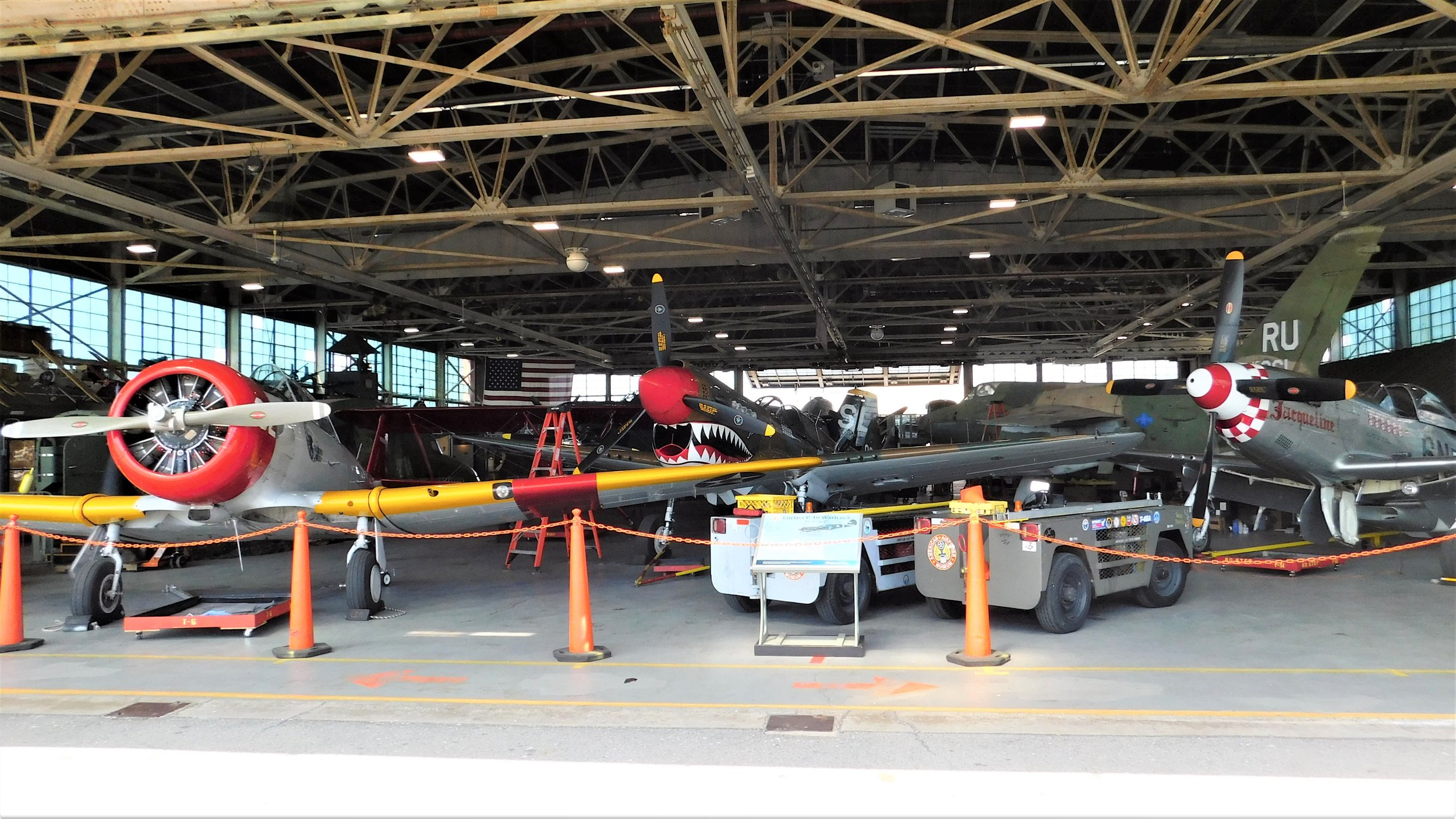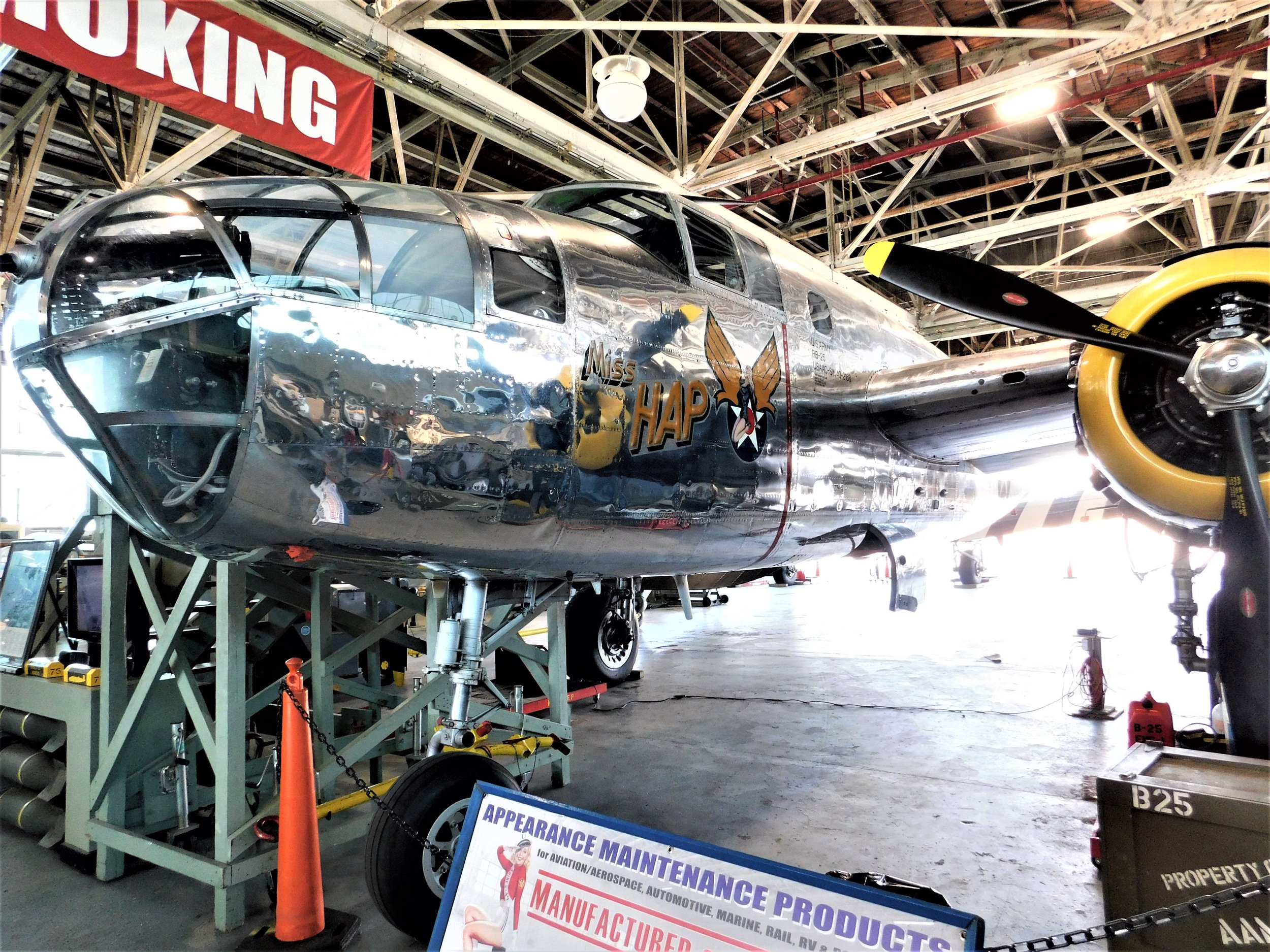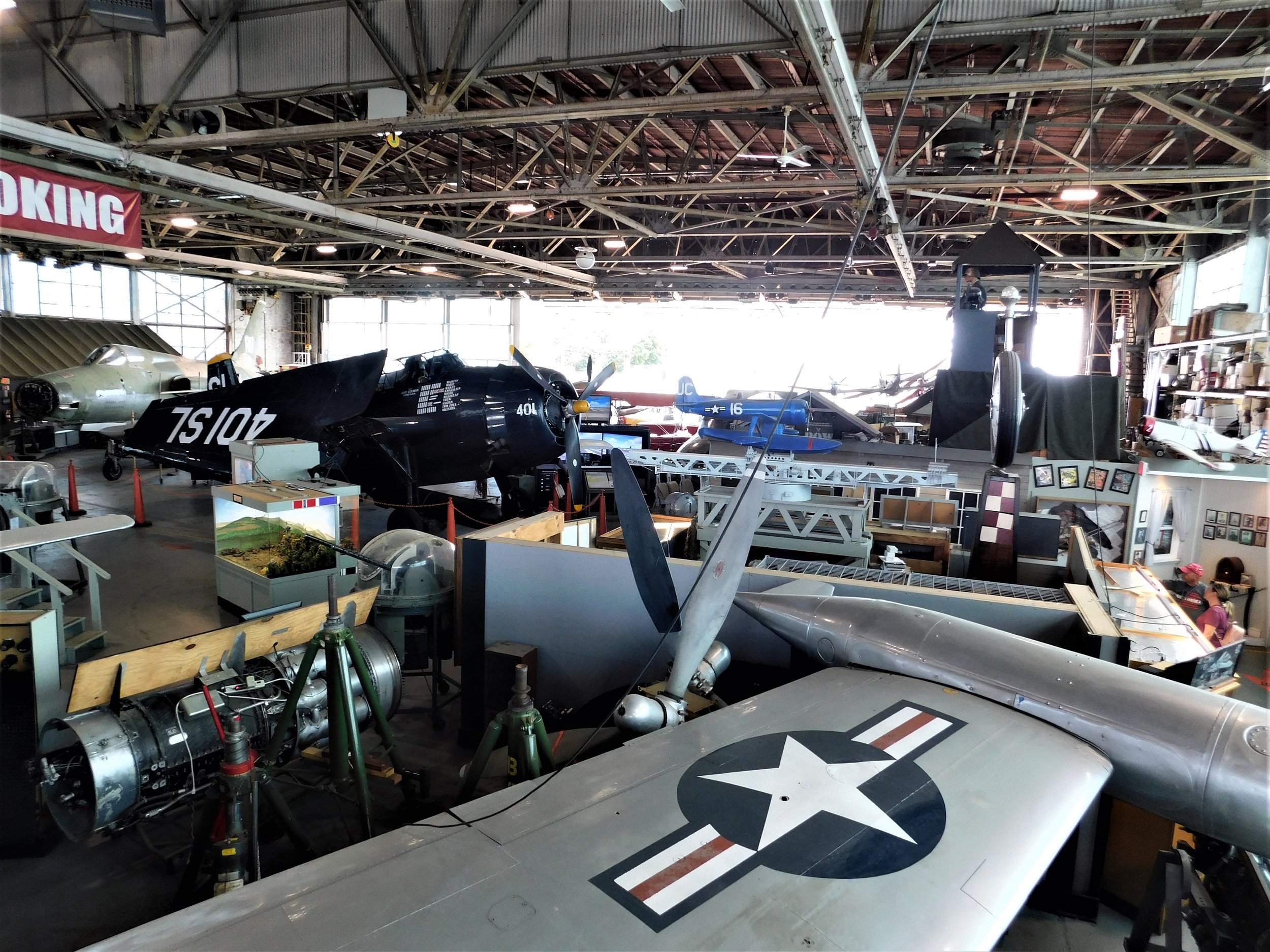American Airpower Museum
Issue 40 A visit to the American Airpower Museum in Farmingdale NY
On 22 March 1958, movie producer Mike Todd died tragically in the crash of his personal plane, a Lockheed Lodestar. The crash, in a mountainous area, was attributed to icing conditions and an overloaded plane. Todd’s wife, the film star Elizabeth Taylor, was supposed to have travelled on the flight to New York with Todd but had remained in Hollywood with a bad cold. It was reported that Howard Hughes sent one of his personal aircraft, a VIP configured B-25 Mitchell, to Hollywood to take Miss Taylor to New Mexico where the crash occurred. That plane, Serial number 40-2168, is still maintained in flying condition and is on display at The American Airpower Museum. There are other unique aspects to the B-25 “Miss HAP” which we will see later.
Situated on Republic Airport in Farmingdale NY, The American Airpower Museum was founded in 2000 by aviation enthusiast Jeff Clayman. The museum’s location itself is historic. Republic Airport was founded in 1927 by Herman Fairchild and was originally called Fairchild Flying Field. Fairchild moved his operation to Hagerstown Maryland in 1931 and Grumman Aircraft Engineering began operations at the field in 1932 (they later moved to Bethpage, also on Long Island). Republic Aviation (originally Seversky Aircraft) arrived in 1939 and it became Republic Airport. Republic built more than 9,000 P-47 Thunderbolts in Farmingdale during World War 2. They continued building aircraft through the Korean and Vietnam Wars, including the F-84 and the F-105. The A-10 was the final Fairchild Republic fighter/attack aircraft built here.
Located in an original hangar from 1940, The American Airpower Museum is a working museum and a number of the aircraft are maintained in flying condition. Museums that have flying aircraft are, by necessity, laid out in a different style than those that don’t. Obviously, flying museums are organized so that doors can open and aircraft can be moved around. This makes it more difficult to organize and maintain static display cases and artifacts, especially for museums that are located in just one building, like this one. The museum does a good job of blending the working and non-working displays.
The original manufacturing area of the airport is now a shopping center and the museum hangar is one of just three original WW 2 buildings remaining on the field. It may be the only museum in the country located in an actual WW 2 manufacturing building. This hangar was Republic’s final assembly hangar and it was here that all the fluids were added in preparation for test flying. In fact, the hangar has a basement (not open to the public) that contains an ammunition vault. Prior to their test flights, the P-47 guns were armed here and the test flight included firing and sighting the guns.
In 1965, Republic Aircraft was acquired by Fairchild Hiller Corporation. Manufacturing at Republic airport continued, and the A-10, a Fairchild Republic product, was named the Thunderbolt II in honor of the Republic P-47 Thunderbolt. We have seen a number of A-10s at museums in this series, but this particular A-10, serial number 80-0247, is 99% complete and is probably the most complete A-10 in a museum anywhere. Many military and civilian jet aircraft on display have had their engines removed (unlike a prop aircraft, a missing engine on a jet is not necessarily obvious and doesn’t detract from the display). This plane not only has original engines but the cockpit is intact, as are the original armaments, very unusual for a museum piece
This P-51D, “Jacqueline” is one of the museum aircraft that is maintained in flying condition. It is a popular attraction at airshows throughout the Northeast.
The history of the North American P-51 Mustang is well known, and it is perhaps the most famous fighter from WW 2. Designed in 1940 for an RAF request, the P-51 originally had the Allison V-1710 engine. The first version (P-51A) was a successful ground attack aircraft, but it lacked performance above 15,000 feet. The updated P-51 B/C had a supercharged Rolls-Royce Merlin engine. This resulted in excellent performance at high altitude as well as longer range, both of which were needed for bomber escort over Germany. More than 15,000 P-51s were built. The most produced model, the P-51D, had a Packard V-1650 engine with a two-stage supercharger. This was a license built, but highly modified, version of the Rolls-Royce Merlin. The P-51 continued to serve after WW 2. At the start of the Korean War, it was a front-line fighter until enough jet aircraft became available. By this time, the Mustang had been re-designated the F-51 and it served in the Reserves until 1957.
The museum’s P-51D, serial number 44-63542, was built at the main North American plant in Inglewood, CA in 1944. It was shipped to Italy to serve in the USAAF 15th Air Force, but remained in reserve until the end of the war. Placed in storage after the war, she was returned to active status in 1947 and served with active duty and Reserve squadrons until 1956. It has been in civilian hands since 1958.
Two types of displays that I always enjoy seeing at a museum are dioramas and life-size re-creations. The American Airpower Museum has several examples of each- all very well executed.
This large diorama depicting preparations for D-Day was built by Dr. Herbert S. Arm, a member of the Long Island Air Force Association. The highly detailed exhibit shows preparations for crossing the English Channel on 6 June 1944. All the elements of the amphibious invasion are here, LSTs loaded with tanks, Jeeps, trucks, and lots of troops, as well as larger ships dock-side.
From these close-ups, you can see the great detail and authenticity in the diorama.
Included in the diorama is an airstrip that also has fine detail, including planes, ground equipment, support buildings, and a typical WW 2 control tower.
A C-47 prepares for takeoff towing a Horsa glider, each with their newly painted D-Day stripes. A B-17, which would operate at high altitude and not need identification markings, is being fueled and armed nearby. Note- this model is built to an exact scale (1/87, I believe). It is interesting to see how large the Horsa glider is compared to the B-17 (it was much lighter, of course).
The many D-Day air fields and ports of embarkation were not usually co-located. This diorama is not of a specific port or airfield, but it is a general representation of D-Day preparations, and it is an excellent one.
Parked close to the D-Day diorama is this C-47, 44-76717, “Second Chance”. The Dakota is painted to honor the 439th Troop Carrier Group that carried paratroopers of the 101st Airborne Division from England to their drop zones in and around St. Mere Eglise in Normandy on D-Day.
The C-47 is open to climb inside, another feature that I always appreciate in a museum.
This C-47, like the A-10 we saw earlier, is very original. The C-47B was built in 1944 and flown directly to England. In 1945, it was transferred to the RAF, where it served through the end of WW 2. It served during the Berlin Airlift (1948-49) and went on to serve with the French Air Force during the Vietnam conflict and then served with the Israeli Air Force until 1996. The museum acquired this historic C-47 in 2000. The fact that it was never used in civilian cargo operations is the reason that it remains very much in its original WW 2 condition.
“Second Chance” is one of the museum’s flying aircraft that visitors can take a ride in. The C-47 ride is a full “fly back in time” event as the participants ride with a group of WW 2 re-enactors, making for a great experience. I didn’t visit on a flying day, but I plan to return to Long Island to experience the C-47 on a D-Day flight.
This is one of a number of interesting life-size re-creations in the museum. This vignette illustrates the role of female reporters during WW 2. Some of the other displays are of the Republic factory during the war. They are difficult to photograph because of the Plexiglas fronts. See the photo gallery at the end for some more re-creations.
This Curtiss P-40 Warhawk is painted to honor the First American Volunteer Group (AVG), better known as the “Flying Tigers”. Formed before the U.S. entered WW 2, the Flying Tigers were commanded by Claire Chennault for the Chinese military, mainly to keep the Burma Road open to China.
All of the aircraft on display are well described on information boards near the aircraft. The one next to the P-40 is especially informative. It notes that this plane originally flew for the RCAF and is one of a group of 35 P-40s that came to the U.S. from Canada following WW 2. A barge captain in Vancouver bought the surplus planes for $50 each, barged them to Seattle, and sold them at a profit. The majority of Warhawks now on display in the U.S. were in that group.
This TBM-3E BuNo 85886 in another aircraft maintained in flying condition by the museum. The Grumman Avenger was originally designated the TBF and was redesignated the TBM when production was taken over by General Motors. General Motors Eastern Aircraft took over production of the Avenger as well as the F-4-F Wildcat when Grumman’s Long Island facility ramped up, in 1942, to produce the very successful F-6-F Hellcat. The Navy’s system of designating aircraft has a certain logic, but can be very mystifying. If you are interested in the history of Naval Aircraft, and their designations, a must have reference book is United States Navy Aircraft since 1911 (Swanborough & Bowers). In 1962, the Navy adapted a common system of designating aircraft with the other services (not without much debate, I am sure. The Navy is nothing if it isn’t traditional!). I was lucky to serve in the Navy after 1962, so I flew the Grumman C-1A and the Douglas C-117D, not the TF-1 and R4D-8!
The Avenger is part of a private collection and is on loan to the museum. It was the first flying aircraft in the museum and has been part of the collection since 2000. Built in Trenton NJ in 1945, it served in training and development squadrons during and after the war. It was also assigned to NAS Atlantic City and aboard the USS Saipan. She first had a civilian registration in the 1960s, being used as a crop sprayer and tanker. In the 1980s, 886 was returned to military configuration and has taken part in warbird events ever since.
On 7 April 1944, a Consolidated B-24H Liberator, 42-7525, left Westover Field MA on a routine training flight. They flew towards the Montauk gunnery range and, on the way, they broke formation due to an engine problem. The plane, and crew of 11, was never heard from again and, at the time, no wreckage was found. In 2013 this landing gear strut was pulled up in a fishing net off of Shinnecock Inlet and it is assumed to be from the lost B-24. It is displayed in the condition it was found in- resting on the ocean floor.
Every museum has their own style of displaying their artifacts. One of the interesting parts of visiting a museum is to see something unique like this and the display is a fitting tribute to the 11 crewmen. They are not remembered as combat heroes but they certainly gave their lives in service to their country, and deserve to be honored.
There are a number of displays that follow the history of Republic Aircraft here in Farmingdale. This series of photographs gives a great pictorial overview.
Early production at Republic Airport. The plane in the picture is the Seversky BT-8 basic trainer. It was the first all metal trainer and the forerunner of the P-35 which led to the Republic P-43 Lancer and then the P-47 Thunderbolt, all designed by Alexander Kartveli.
The P-47 Thunderbolt production line. These are P-47 B models, dating the photograph around 1942.
The F-84 Thunderjet was produced here between 1949 and 1953, with a total of 7,524 being built.
The F-105 Thunderchief was a frontline fighter during the Vietnam War- especially during the early stages. It remained in service until 1984 as the RF-105 Wild Weasel version. The F-105 was produced here from 1955-1964 with over 800 being built. At the time it was the largest single seat, single engine, aircraft ever built.
Production in the factory came full circle in 1972, with the introduction of the Fairchild Republic A-10 Thunderbolt II. Between 1972 and 1984, over 700 of the amazing Warthogs were built and it is still in active service today.
This is one of three Republic F-84s in the museum’s collection. The F-84 had an interesting development history, having originally been produced with a straight wing. After the swept wing version was introduced, the straight wing version continued in production. This is an F model. Another version, the RF-84F had the engine intakes in the wing roots, to allow for cameras in the nose. The museum has an F-84F, RF-84, and a straight-wing F-84E. At one point, the museum had on display at least one of every aircraft built by Republic (the P-47 was unfortunately lost during an airshow in 2016).
Let’s return to the North American B-25 “Miss HAP” in the opening story. As mentioned, this particular Mitchell, 40-2168, has an interesting history. Built in 1940-41, it is the oldest B-25 in existence. It was one of the first batch of 24 built during the pre-war build up. As such, it is just a B-25, with no additional suffix (such as B-25H). The original design of the B-25 had a straight wing but, early on, control issues were discovered and the wing was converted to more of a gull wing design. This plane was one of the first nine built that were built with a straight wing and later converted to the new wing design. I have mentioned before, but I think it is worth repeating, the Mitchell is the only U.S. military aircraft ever named after a person. General Billy Mitchell, a WW 1 ace, advocated strongly for a separate Air Force, and today is considered the father of the Air Force. He was demoted, then court marshalled, for his views and died in 1936, before his views on strategic bombing and a separate Air Force were validated.
Originally this Mitchell was assigned to the 17th Bomb Group, 34th Bomb Squadron at McChord field in Washington State where she served in a variety of training roles. In 1943, she was one of two returned to the factory and converted into a VIP transport (it still has that original VIP interior). Upon completion, the VIP B-25 was delivered to General Hap Arnold (hence the name) for his personal use and stationed at Bolling Field in D.C. In 1944, it was replaced with a newer plane but continued to serve in various VIP transport roles until the end of the war.
Photo courtesy of Larry Starr
The B-25 was purchased for surplus after the war and operated by several owners, including Howard Hughes. It was purchased by museum founder, Jeff Clyman, in the 1980s. “Miss HAP” is a beautiful aircraft with a remarkable history. It is truly unique for an aircraft like this to still be flying.
The American Airpower Museum has so many interesting parts to it that it is impossible to do it all justice in just one blog. When you visit, be sure to give yourself enough time for a thorough tour. If you call ahead, you may be able to visit on a day when one or more of these special planes are flying.
A special thanks to Larry Starr for his assistance in my research.
And thanks to my wife Sheri and our dog Henley who hung out while I toured the museum!
————————————————————————
To learn about what to do in the local area, museum hours and costs as well as books to read and other interesting odds and ends, keep reading! At the end you will find a photo gallery of the entire museum.
PLANNING YOUR VISIT
Hours of Operation
Monday Closed
Tuesday Closed
Wednesday 10.30 am-4.00 pm
Thursday 10.30 am-4.00 pm
Friday 10.30 am-4.00 pm
Saturday 10.30 am-4.00 pm
Sunday 10.30 am-4.00 pm
General Admission
Museum Members Free
Adults $15.00
Children (5-12 years old) $10.00
Children (4 years old and under) Free
Seniors (65+) $12.00
Veterans/Retired Military w/ID $12.00
Active Law Enforcement / Firefighters w/ID $12.00
Active U.S. Military w/ID Free
FLYING IN
Republic Airport (KFRG) is a public airport with Runway 14/32 (6833’) and Runway 01/19 (5516’) with an ILS to Rwy 14 and RNAV approaches to all runways. It is a corporate airport with four FBOs on the field. The museum is on the north end of the field near the approach to 19. Modern Aviation is the closest FBO.
LOCAL ATTRACTIONS
The American Armor Museum is not far away and really worth a visit. https://www.museumofamericanarmor.com/
Eastern Long Island has a number of family attractions such as vineyards and beaches.
WHERE TO EAT
The area around the airport is built up, with a number of shopping centers and restaurants of all types.
SUGGESTED READING
Reader Ed Gutsky recently suggested No Man’s Land by Kevin Sullivan. This is a true story of a Quantas A-330 that had a serious malfunction of the fly-by-wire control system. It is a well written account of the incident and the long flight to a divert field, while dealing with unknown control issues in the cockpit and major injuries in the passenger cabin. It is a well written page-turner and perhaps a cautionary tale about turning over the control of our planes (and cars) to computers. Thanks Ed!
MUSEUM WEBSITE
https://www.americanairpowermuseum.com/
UP NEXT
The Air Heritage Museum, Beaver Falls PA
MUSEUMS ARE WHERE YOU FIND THEM
This segment is dedicated to finding interesting aviation artifacts that are in public view- but not in an aviation museum. If you see one send a photo!
My wife Sheri and I recently visited this WW 2 blimp hangar in Elizabeth City NC. The hangar was built to house blimps that were used for coastal patrol, looking for U-Boats, during the war. It is the home of TCOM, L.P. who build the aerostat and mooring station for surveillance systems here today.
There were eventually two hangars built in this location. The first, as you can see, was built of steel. The second was built later in the war and, due to steel shortages, it was built of wood. That hangar, unfortunately, burned down in the 1990s, with just the concrete superstructure remaining. Many thanks to Randy Stark for a great tour!
If you are ever in eastern North Carolina, Elizabeth City is a pleasant little seaport town and worth a visit. There is an excellent museum, The Museum of the Albemarle, and a number of historic places to visit including the Great Dismal Swamp and canal. Elizabeth City is where the Wright Brothers embarked for their trip across the Albemarle Sound each time they visited the Outer Banks. At the museum you can pick up a brochure “Aviation Trail” that points out other Wright Brothers connections in town.
https://www.museumofthealbemarle.com/
PHOTO GALLERY
Click any photo to enlarge
Issue 40, Copyright©2023, Pilot House Publishing, LLC. All rights reserved.
Except where noted, all photos by the author
A few other “thanks” that I should add to all of my blogs. My son Mark and his wife Taylor helped me do the initial design of the blog and website; my son Eric is always helpful with technical questions; my son AJ not only offers technical advice, but is very generous with offering rides to museums in his Baron; and my daughter-in-law Angela often has valuable input and suggestions. My brother Mike edits the blog each month with very valuable input. Above all, my wife Sheri provides support and encouragement and often accompanies me on museum visits. A huge thanks to everyone.
